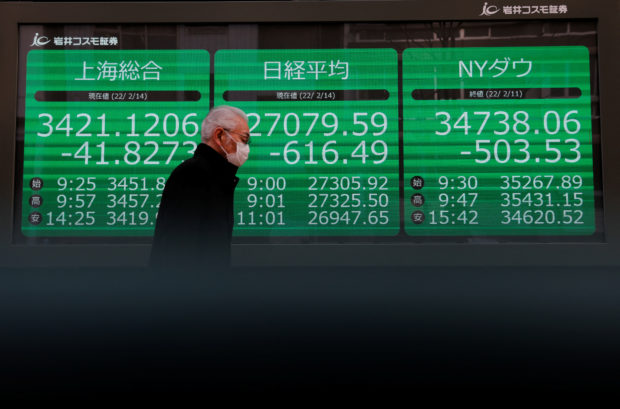
A man wearing a protective face mask, amid the coronavirus disease (COVID-19) pandemic, walks past a screen showing Shanghai Composite index, Nikkei index and Dow Jones Industrial Average outside a brokerage in Tokyo, Japan. File photo REUTERS/Kim Kyung-Hoon
TOKYO – Asia stocks tumbled on Tuesday as jitters about an escalation in Sino-U.S. tension with U.S. House of Representatives Speaker Nancy Pelosi set to begin a trip to Taiwan, adding to fears about the risk of global recession.
U.S. long-term Treasury yields dropped to a four-month low, pulling the U.S. dollar down, amid a bid for safer assets after China threatened repercussions in the event of the visit by Pelosi to the self-ruled island, which China claims as its territory. Crude oil also sank.
Meanwhile, Australian stocks pared declines and the Aussie dollar weakened after the central bank raised the key rate by an as-expected 50 basis points, with markets interpreting changes to the accompanying policy statement as dovish.
Japan’s Nikkei slid 1.54 percent, while Taiwan’s stock index dropped 1.87 percent.
Chinese blue chips tumbled 2.47 percent and Hong Kong’s Hang Seng lost 2.71 percent.
However, Australia’s equity benchmark was just 0.23 percent lower, after an earlier decline of 0.7 percent.
MSCI’s broadest index of Asia-Pacific shares retreated 1.33 percent.
U.S. e-mini stock futures pointed to a 0.44 percent lower restart for the S&P 500, which stumbled 0.28 percent overnight.
“We knew from the onset that (Pelosi’s trip) would be a driver of risk-off sentiment in the region,” said Carlos Casanova, the senior Asia economist at Union Bancaire Privee in Hong Kong.
“There’s going to be a lot of speculation and uncertainty about what the extent of China’s response will be in the short term.”
The week began with China, Europe and the United States reporting weakening factory activity, with that in the U.S. decelerating to its lowest level since August 2020.
That sank crude, with Brent futures edging down to $99.27 a barrel on Tuesday after losing almost $4 overnight. U.S. West Texas Intermediate futures also eased to $93.26, extending Monday’s almost $5 slide.
The benchmark 10-year U.S. Treasury yield fell as low as 2.53 percent in Tokyo trade, the lowest since April 5, amid wagers the slowdown could spur the U.S. Federal Reserve to ease off the policy-tightening pedal. The bonds also benefited from safety-seeking demand before Pelosi’s Taiwan visit.
That helped the U.S. dollar slide as low as 130.40 yen for the first time since June 6. The euro jumped as high as $1.0294, a level not seen since July 5.
The Taiwan dollar slipped to its lowest level in more than two years on the weaker side of 30 per U.S. dollar.
Meanwhile, the Aussie was 0.51 percent lower at $0.69910, extending a 0.14 percent retreat following the Reserve Bank of Australia’s policy decision.
It had hit the highest since June 17, at $0.7048, in the previous session but that was after bouncing off a 26-month trough at $0.66825 in the middle of last month.
“The Aussie has been underperforming other major currencies lately given global growth concerns so it really needed a hawkish surprise to reignite its recovery from 2-year lows,” said Sean Callow, a currency strategist at Westpac in Sydney.
“Instead, it got the RBA leaving the door wide open to slowing the pace of tightening at future meetings, sending AUD back below $0.70.”